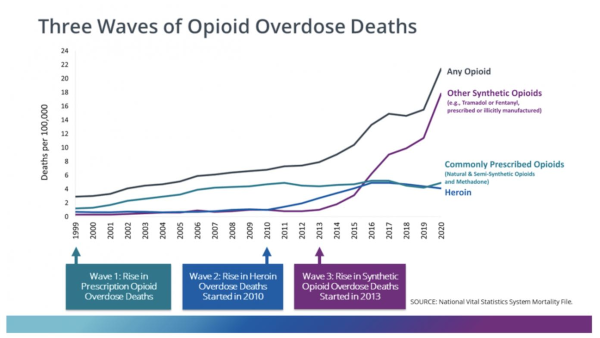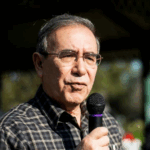
Editor’s Note: This article was originally published in our sister publication, Tribuno del Pueblo, at www.tribunodelpueblo.org
- Covid-19 deaths and narcotics overdoses combined are the two main reasons the life expectancy of Americans fell for the first time ever. (https://www.health.harvard.edu/blog/why-life-expectancy-in-the-us-is-falling-202210202835)
- Whereas 80% of Covid deaths were older than age 60, most opiate deaths were young and middle-aged. Fentanyl is the number one killer of 18- to 45-year-olds in this country. (https://www.npr.org/2021/12/30/1069062738/more-than-a-million-americans-have-died-from-overdoses-during-the-opioid-epidemic)
- 108,000 Americans died of narcotics overdoses last year, including to fentanyl which is 50 times more potent than heroin, and 100 times more powerful than morphine. (https://americanaddictioncenters.org/fentanyl-treatment/compare)
Now it seems a settlement to address the narcotics crisis is unfolding in 2023. Up to $32 billion dollars is being distributed to states from pharmaceutical manufacturers and distributors including Purdue, Johnson & Johnson, McKesson, AmerisourceBergen, Cardinal Health, CVS, Walgreens, and Walmart for their role in the decades long opiate crisis https://www.theatlantic.com/health/archive/2020/01/what-caused-opioid-epidemic/604330/.
It is no secret that Purdue Pharmaceuticals bent rules to widely promote “oxycontin” as a non-addicting alternative to prescription narcotics. And it sent an army of drug representatives to convince and bribe physicians to overprescribe oxycontin. Purdue and the Sackler family have demanded immunity from further suits in their settlement mentioned above. All this is pointed out in the Netflix documentary based on the book Dopesick by Beth Macy.
As described in Dopesick, once injured workers lost their jobs due to their medical conditions, layoffs, or factory closure, they lost their health insurance and medication coverage. They were driven to feed their habit on the streets in the forms of heroin, underground market prescription drugs, and other drugs. They fought to stave off withdrawal symptoms by borrowing and stealing. They were stigmatized and blamed as drug addicts, even by Purdue spokespersons.
With the focus on imprisonment of small-time dealers in the U.S. and large-scale interdiction by law enforcement on the border, the street value of drugs only went up, given the constant demand for drugs in the U.S.
Now the narcotic crisis has reached a much higher and more dangerous level. With the availability of synthetic and more potent narcotics such as fentanyl, large scale cultivation of opium to manufacture heroin is no longer necessary. Ingredients for its production are readily available from China, India, and now Mexico. (https://ktla.com/news/how-fentanyl-makes-its-way-to-the-united-states/) Fentanyl can easily be produced in small, hidden labs anywhere, which is why it is so dangerous.
Since fentanyl is so potent compared to what was available before, it is quickly addictive. While often sold alone, it is also mixed with unrelated drugs like cocaine, methamphetamines, and marijuana to get users to continue to buy since it is so inexpensive to produce. The problem is, since it is so potent, it is causing deaths, particularly among new users, but also because potency varies so widely from batch to batch of drug.
As money flows into the states from the narcotic settlements from producers and distributors, there are no clear guidelines about how it will be used. There is much attention to naloxone, an antagonist to narcotics, which can be lifesaving in an emergency. However, much more needs to be done in terms of harm reduction, which means providing clean needles to exchange for dirty ones to limit exposure to children in playgrounds and decrease the transmission of contagious diseases like HIV, hepatitis C, and others from shared needles. There needs to be more rehabilitation programs and prevention programs, including for released inmates with drug addiction. And many more providers need to be trained to prescribe medically assisted therapy for narcotics addiction such as buprenorphine or methadone, eliminating the legal barriers and stigma of treating narcotics addicts.
The decades long “War on Drugs” is a failure. It focuses almost exclusively on limiting the “supply” side of the problem. The consequences have been mass incarceration domestically of users and small-time pushers. Military grade weapons flow from the U.S. to drug cartels in Mexico and Latin America lead to violent deaths there. People feel less safe on both sides of the border, mourn their dead, and grandparents raise orphaned children, often with little help from the government.
Until the “demand” side of the problem is addressed, the problem will only worsen. Estimated in 2019 at nearly $150 billion in value, the U.S. market for drugs of abuse is the largest in the world.(https://www.sciencedaily.com/releases/2019/08/190820081846.html) Much more attention needs to go to what drives people to drugs in the first place. As painfully related in Dopesick, economic downturn and corporate greed often coincide to make the problem worse. When a plant closes, within 5 years, there is an 85% increase in opioid overdose deaths. Every 1% increase in unemployment leads to a 3.6% increase in opioid deaths.
We have it within our means to solve this problem. Just throwing money at the problem only lets the villains off the hook, with their settlement seen as “the cost of doing business.” Further militarizing or increasing the police force won’t do it either. Solving the narcotics crisis means not only treatment and prevention, but also ensuring all basic needs are met and treating everyone as a valuable, contributing member of society. This is a group effort and where we should put our money and effort.

